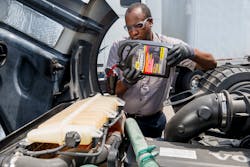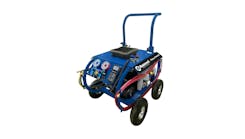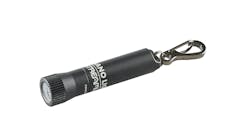When fleets think about regular service for heavy duty diesel engines, coolant is seldom at the forefront of the preventive maintenance list. But, 40 to 50 percent of major engine failures are a result of poor coolant system maintenance, says Homer Hogg, service director, technical service, Travel Centers of America.
Coolant transfers heat from the engine to the atmosphere, protects against scale deposits and provides freezing and boiling protection. Some of the earliest automobiles used straight water as coolant, says Frank Cook, senior vice president, technology, Old World Industries (OWI). The water had to be emptied and swapped with a methanol water mixture for the winter, because straight water would freeze. In the summer, the methanol would evaporate, so they had to use straight water.
“There was a routine of using methanol in the winter and water in the summer,” Cook explains, “and when the first ethylene glycol antifreeze went on the market [in 1927], it was marketed as a permanent antifreeze, meaning it could be used year-round and didn’t have to be swapped in the winter.”
For the next 75 years or so, coolant evolution focused on the corrosion inhibitor system, trying to better protect the metals that are in the engine, responding to OEM system changes and improving the cooling system. “The last 25 years have focused on improving longevity, making coolants last longer,” Cook explains. “Early coolant was all green and only lasted a couple of years. Now, it comes in every color under the sun, and the shortest one lasts 150,000 miles, and a lot of them are longer than that.”
Types of coolant
There are four main types of coolants used in commercial vehicles today:
- Inorganic Acid Technology (IAT). IAT coolants are considered the older technology, green-dyed coolants that vehicles traditionally ran. These coolants required dilution with water, and needed supplemental coolant additives (SCAs) added periodically to protect the wet sleeve liners in the heavy duty diesel engine from pitting corrosion. Additives in IAT coolants are consumed during vehicle operation, so adding SCAs that contain corrosion inhibitors (such as nitrite) helps maintain corrosion protection.
- Organic Acid Technology (OAT). OAT coolants, sometimes called extended-life coolants (ELC), use organic acids as a replacement for other inhibitors, and typically provide 600,000 miles of service life. When these coolants were first introduced, there was some pushback, as the conventional wisdom for coolant maintenance was that coolant needed nitrite to protect the wet sleeve liners from pitting. There was a misconception that the absence of nitrite in this coolant type meant that it did not offer the same protection against corrosion.
- Nitrited Organic Acid Technology (NOAT). NOAT coolants are OAT coolants with nitrite added. These coolants were developed as a sort of bridge gap technology to ease the transition from IAT coolants to OAT coolants. Adding nitrite allowed fleets to test the coolant using nitrite test strips, making maintenance more similar to an IAT coolant. These are also considered ELC coolants.
- Hybrid Organic Acid Technology (HOAT). This coolant is a combination of IAT and OAT inhibitors, and offers the longer life of the organic acid technology and the rapid metal passivation of inorganic technology. Like IATs, some HOATs require SCAs added back into the system to maintain corrosion protection.
The compatibility conundrum
The issue of coolant compatibility is one that hasn’t been fully defined by the industry. Coolant compatibility relates to ‘topping off’ coolant levels by adding new coolant to whatever coolant is already in the system.
As a general rule, fleets should only top off coolants with the same technology that is already in the system. So, if they are using an IAT coolant, they should top off with another IAT coolant, not a newer coolant technology. And, although HOAT coolant uses both IAT and OAT inhibitors, that does not necessarily mean it is safe to add IAT or OAT coolant when topping off. Adding a different coolant technology can change the overall chemistry of the coolant in the system and limit its effectiveness.
“In general, no immediate damage will occur if two similar heavy duty coolants are mixed,” explains Justin Perry, coolant and fluids chemist, Cummins, Inc. “[But,] when dissimilar coolant chemistries are mixed, a point can be reached where neither coolant’s additive package provides sufficient liner pitting and corrosion protection needed for heavy duty service.”
He advises that mixing different coolants should be avoided whenever possible. Even mixing similar coolants can diminish the lifetime and the maintenance interval of the coolant, because one product could be inferior to the other, he stresses.
“Fleets need to understand that they have to do their homework,” says Bryan Stewart, director of maintenance for Jones Logistics. “There are coolants today that can be mixed and will not have a long-term effect on the technology, but others can lead to catastrophic engine damage if the coolants are mixed and diluted. Fleets need to understand what they are running, and why the manufacturers recommend that type of coolant. This is especially important if you run different engine manufacturers, as what works in one may not be suitable for the types of seals or metals in another.”
One notable example is running a NOAT coolant with an aluminum radiator.
“A landmark change in engine construction occurred in the 2000s when vehicle manufacturers, in response to calls for lighter vehicles and components that could lead to improved fuel economy, made the decision to move from radiators constructed of copper or brass to ones made with aluminum,” explains Colin Dilley, vice president of technology, Prestone Products Corporation.
“A highly efficient process called controlled atmosphere brazing (CAB) is used to produce these aluminum radiators, but the CAB process leaves behind residual brazing flux on the aluminum surface, which will react with nitrite,” he continues. “This increases the corrosion rate on aluminum cooling system components and a buildup of corrosion-caused ‘gunk’ in coolant filters.”
Because of this unintended consequence of using CAB-brazed aluminum radiators with NOAT coolant, some manufacturers may recommend using OAT coolant, Dilley advises. In these vehicles, OAT coolants will offer the same level of protection as NOAT, but without the damaging corrosion.
To further complicate matters, you can’t really tell at a visual glance what type of coolant is in a system. Coolant is colorless, and color is added for an easier visual of the fill level. But, although the TMC RP 351 pertains to coolant color standardization, not all manufacturers follow that standard.
“The standard is not widely adopted by coolant manufacturers,” stresses Cummins’ Perry. “In addition, color is subjective, and not everyone views color the same way. Many coolants are varying shades of red or pink – some are OAT, some are NOAT and some rely on older IAT technology. In other words, we should not be using color to identify coolants or evaluate the compatibility of two products.”
TA’s Hogg concurs. “Perhaps one day the color of coolants will be standardized, but today you just can’t rely 100-percent on color being the only way of determining what type of coolant is in the cooling system,” he says. “Detailed records must be kept on each truck, and [we recommend] that a sticker be used on the truck near the radiator cap or surge tank cap to help identify what type of coolant is in the truck’s cooling system.”
If you don’t know what type of coolant is being used, test it, urges Jones Logistics’ Stewart. Do not base your coolant purchase on the color of what is in the radiator or surge tank. “Test it,” he advises. “Even if you’re sure what you run, test it.”
Consequences of coolant failure
In the event of coolant failure, fleets could experience anything from an overheating issue, to a leaky water pump, to major engine damage.
“Basically, any metal surface inside the engine that the coolant is supposed to protect can be at risk for damage,” Stewart says.
Possible effects of coolant failure include:
- Cavitation or wet sleeve liner pitting. A wet sleeve liner is a sleeve inserted in diesel engine blocks to improve heat transfer and improve serviceability of heavy duty engines. In untreated systems, imploding bubbles of air bore through the steel liners, eventually resulting in perforation of the liner wall, which allows coolant to enter the combustion side of the chamber. Coolant could also leak into the engine oil, which can overheat lubricated moving parts and destroy the engine. In treated systems, imploding bubbles of air are blocked by inhibitors in the coolant – typically, nitrite in conventional coolants and organic inhibitors in ELC coolants. These inhibitors act as a protective barrier to prevent corrosion and cavitation erosion from occurring.
- Scale. Scale is the hardening of minerals from water in the cooling system. Scale blocks the efficient transfer of heat, causing overheating that could result in: cracked heads and warped engine blocks; abnormally high oil temperatures; failure of the coolant system fan to turn on; and heaters could be blocked. TA’s Hogg says, “1/16” of scale reduces cooling system heat transfer efficiency by 40 percent.”
- Corrosion. Corrosion is the natural tendency of metals to revert back to their ore form. Corrosion destroys cooling system metals and parts. Using a modern coolant that meets TMC RP 329 should provide the necessary protection to avoid corrosion problems, as long as the coolant is properly maintained.
- Silicate drop-out. Sometimes referred to as “green goo,” silicate drop-out can be caused by using an automotive-grade conventional coolant with high silicates in diesel engines, or by over-charging SCAs. Excess phosphates and silicates will drop out, causing deposits or a sludge-like consistency that can result in premature water pump failure, radiator blockages, heater core problems and extensive down time. Using low-silicate and phosphate-free fully-formulated or ELC coolant helps eliminate the potential for “green goo.”
“Coolant failure doesn’t happen overnight,” OWI’s Cook says. “It just slowly degrades, and if you let it get out of whack, you’re going to have cavitation in the wet sleeve liners and you’ll begin to corrode the actual metals themselves. It’s important to try not to let coolant get too much out of kilter.”
Coolant maintenance for maximum uptime
“It has commonly been said that about 40 percent of all engine failures are related to the health of the cooling system,” says Brian Liimatta, customer support manager, Cummins, Inc. “Ensuring proper coolant selection, establishing a consistent testing regimen and following proper coolant maintenance practices are critical to achieving maximum uptime.”
Visually inspecting coolant is a helpful first step, says Prestone’s Dilley. Look for suspending particles, a thin, watery appearance or a sludge-like appearance – these can be indicators of problems in the system.
To get a more thorough understanding of the quality of the coolant, though, a comprehensive inspection is needed. First, use a refractometer to test the relative concentration of ethylene glycol in the solution (generally, this should be about 50 percent). Refractometers can give a relatively accurate determination of the coolant’s freeze point and glycol content in seconds, says Cummins’ Liimatta.
The pH levels, level of nitrites (if applicable) and inhibitor package levels should also be tested. Test strips are available to test freeze point, additive levels, pH and the presence of some contaminants, such as chloride and sulfate. This is a quick and easy way to test coolant, Dilley advises.
However, Liimatta also emphasizes that test strips have some limitations. “Many are sensitive to factors such as color, coolant temperature at the time of test, humidity and temperature at which test strips are stored and the lighting under which test strips are read,” he says.
Test results can be subjective, and aren’t precise enough to give more than a ballpark determination, he adds. But, when used correctly, test strips can produce enough information to track coolant condition and make decisions regarding coolant maintenance in most cases.
When coolant gets topped off, it refreshes the inhibitors, so topping off with a like technology can help maximize the life of the coolant, OWI’s Cook says. “As long as [fleets] top off with a like technology, maintain the glycol of the coolant and test periodically with a test strip, coolants can last the life of the vehicle,” he says.
He adds that if fleets notice that the coolant doesn’t look right upon visual inspection and it has an unusual color or odor, or if the regular preventive maintenance tests yield ambiguous results, sending a coolant sample for laboratory testing is also an option. “We have the capability to look at degradation products, inhibitors present and can really fingerprint what’s going on in your system by doing that coolant analysis. It’s not cheap, so it’s prohibitively expensive to do as a regular PM item, but it can help you get to the bottom of a coolant issue.”
Lab testing can be helpful as an investigative tool when cooling system related failures occur and can help pinpoint where the fleet’s current coolant maintenance program may be going wrong – whether that means testing more frequently, testing with more accurate tools or using a different coolant more compatible with the metals in the system.
If a fleet notices consistent coolant loss and there is no evidence of an external leak, it is possible that the coolant is entering the exhaust system through the EGR cooler or doser block, TA’s Hogg says.
“If coolant enters the exhaust, it will move on the DPF and could cause severe damage,” he cautions. “If coolant is disappearing from the system, the source of the leak must be identified and corrected. Failure to react in a timely manner means the aftertreatment system is suffering damage, and topping off the coolant system could be introducing contaminants or could result in an imbalance of coolant and water. Either condition will be costly over time.”
It is normal for fleets to have to top off their coolant levels occasionally, but if they find that they need to add coolant every time, or if the drivers need to add coolant because it is chronically low, then that is indicative of a leak somewhere in the system that needs to be addressed before it causes larger damage.
There are recommended testing intervals set by the coolant manufacturers, which offer a good baseline for how frequently to check coolant, adds Jones Logistics’ Stewart. “I personally feel that fleets should develop their own set of guidelines for testing based on how they use the equipment in their fleet. We like to test it at every oil change, but like so many other areas in our industry, there is never a one-size-fits-all strategy when it comes to equipment maintenance.”
“Coolants based on inorganic additive technology and hybrid/NOAT products should be tested at minimum for freeze point and additive content twice per year,” Liimatta says. “More severe duty cycles may require more frequent coolant testing and maintenance. Coolants based on organic additive technology [OAT] should be tested for freeze point and additive content at least once per year.”
He suggests that at minimum, fleets test their coolant any time maintenance is performed on the cooling system, there is a cooling system related failure or an issue within the cooling system is suspected.
Today’s ELC coolants can last 600,000 miles or more, Cook says. “The key behind keeping that longevity is maintaining the coolant. Really, it’s almost as simple as [using] a good coolant with a reputable background, test it whenever you do regular PM or an oil change and ensure that you’re topping off with the same technology you have in there in the first place,” he says. “If you do that, you can easily get the life out of the coolant that it’s marketed to have, and in some cases, coolants can last the life of the vehicle.”
Conclusion
Although coolant maintenance may seem deceptively simple, coolant does degrade over time, and coolant failure can cause major vehicle damage and unplanned downtime.
“Do not ignore your coolant during maintenance,” Jones Logistics’ Stewart advises. “ELC does not mean you put it in the truck and never have to worry about it again. Maintain it.”
Catching coolant issues early, before they can cause more severe problems or engine issues, will maximize uptime and save fleets money.



